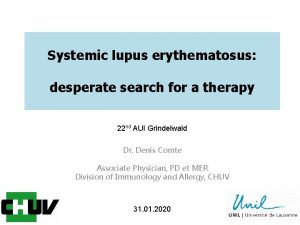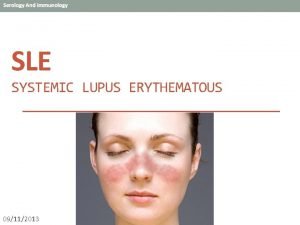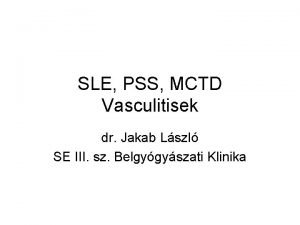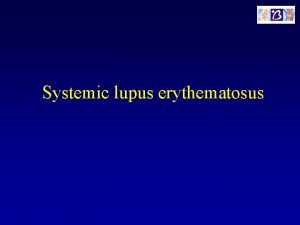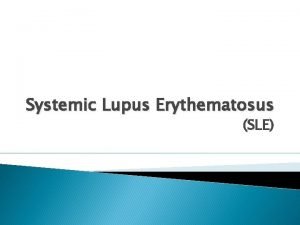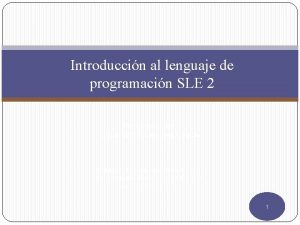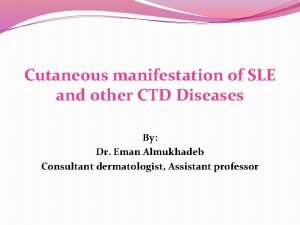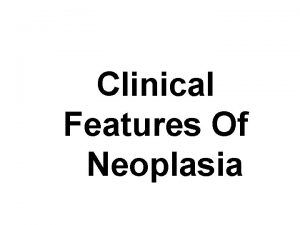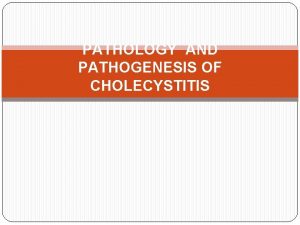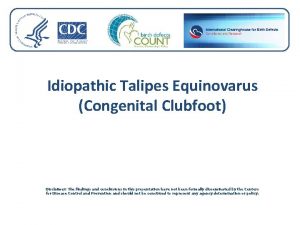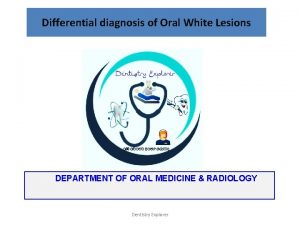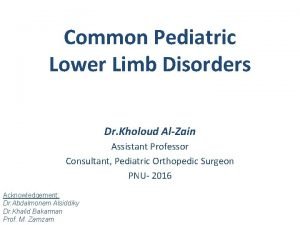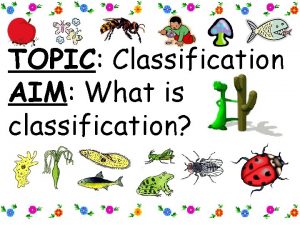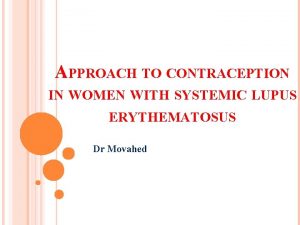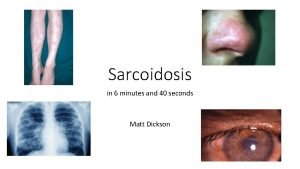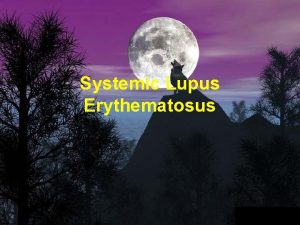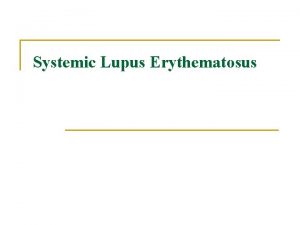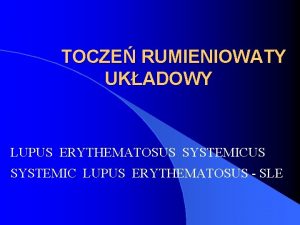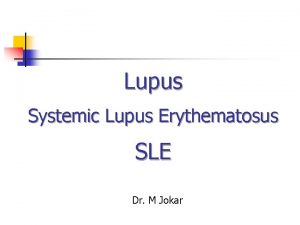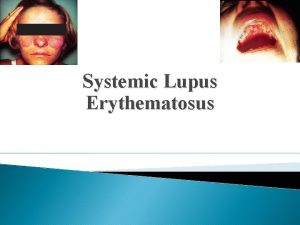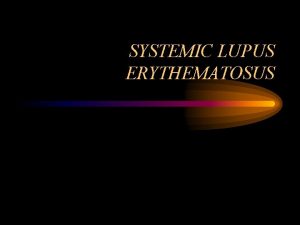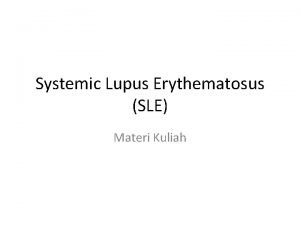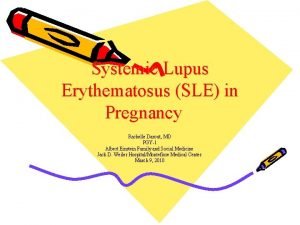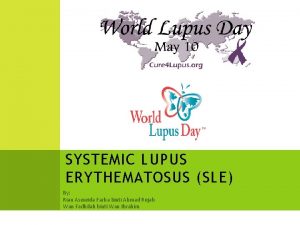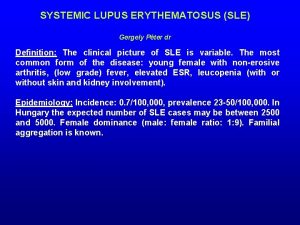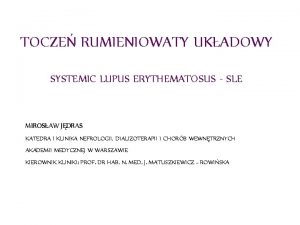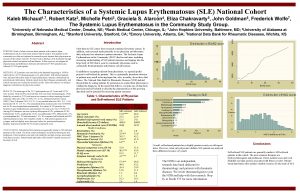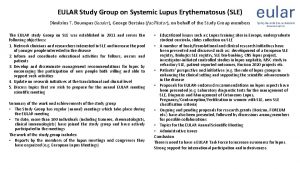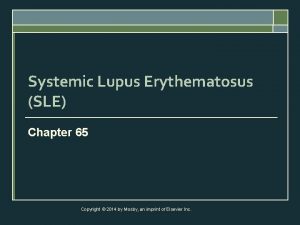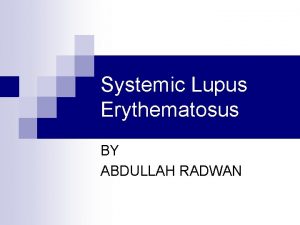Systemic Lupus Erythematosus SLE Clinical features A chronic
































- Slides: 32

Systemic Lupus Erythematosus (SLE) • Clinical features • A chronic autoimmune disease with variable tissue injury in multiple organs, including kidney, brain, skin, joints, heart, lungs, muscles and blood • Strong genetic predisposition MHC and non MHC immune response genes, females>> males (>10/1) • The onset may be insidious or fulminant, typically appearing in a previously healthy person in adolescence or young adulthood • The course is characterized by multiple flares and remissions • Therapy involves intensive use of high dose corticosteroids and alkylating agents or other non specific immunosuppressive drugs

Major Clinical Manifestation of SLE Manifestation Arthralgias/arthritis Hematological Rash Fever Neurologic Renal Pulmonary Cardiac Percent 95 90 81 77 59 53 48 38

Lupus Erythematosus: Epidemiologic findings • Primarily a disease of young adults Peak incidence age 15 -45 • Marked female preponderance Sex ratio during peak incidence is 10 : 1, female : male • Distinctive ethnic distribution Greatly increased incidence among African-Americans (0. 3%), compared to Caucasoids or Blacks in Africa. Similarly increased incidence among Hispanics, Mestizo Indians in Mexico, Sioux Indians, and generally among Chinese and Filipinos, but not among most other Asian peoples.

Systemic Lupus Erythematosus (SLE) • SLE is the prototypic systemic autoimmune disease where the dominant autoimmune response is the production of an array of autoantibodies to self antigens including nuclear components (DNA, RNA, histones) as well as autoantibodies to cell membrane determinants on hematopoietic cells including (RBC, platelets and leukocytes). • The autoantibodies induce injury by forming immune complexes with autoantigens which deposit in vessels walls to cause vasculitis and glomerulonephritis. The auto antibodies may also directly bind to cell membranes and destroy cells by activating complement killing and by triggering Fc. R mediated inflammatory and cytotoxic mechanisms. • The B cell autoantibody response is in turn driven by MHC-restricted CD 4+ T cells that recognize self peptides likely bound by HLA-DR 2 & DR 3 MHC molecules.

Clinical features of SLE which reflect an ongoing immune response • lymphadenopathy with active germinal center formation, splenomegaly • polyclonal hypergammaglobulinemia • anti-nuclear antibodies, anti-ds. DNA, multiple antibodies to other nuclear structures • lymphopenia, thrombocytopenia, hemolytic anemia • cytokine mediated systemic phenomena: fever , malaise, weight loss (TNFa, IL-1 b)

Autoantibodies in SLE I. Antibodies to DNA double-stranded DNA (unique to SLE) double- and single-stranded DNA II. Antibodies to Deoxyribonucleoprotein Antigen: complex of DNA and histone III. Antibodies to Other Nuclear and Cytoplasmic Constituents histones nonhistone nuclear proteins a. Small nuclear ribonucleoproteins (sn. RNPs) Sm antigen (SLE specific), Ro / La, b. ENA (not specific for SLE), RNA IV. Antibodies to Cell Membrane Antigens red blood cells, platelets T cells, B cells, macrophages, granulocytes b 2 microglobulin, cardiolipin V. . Antibodies to soluble proteins Anti-Antibodies: rheumatoid factors Anti-b glycoprotein 1, clotting factors

Antinuclear autoantibodies in SLE Anti ds. DNA antibodies are highly specific for SLE Rim ANA pattern on Hep 2 cells that accompanies anti ds. DNA antibodies, may include anti lamin and anti Ku Anti ds. DNA staining of Crithidia kinetoplast. Very specific

Antinuclear autoantibodies in SLE Anti histone and anti DNA antibodies (nucleosome) Anti ds DNA (>50 -75%), Specific for SLE Anti ss. DNA, non specific Anti histone (30 -40%)SLE, not specific for SLE, >90% in drug induced lupus

Many SLE autoantigens are large complexes of RNA and multiple proteins Anti Ro 52 k. D, Ro 60 k. D, La • Four small uridine-rich RNA molecules, h. Y 1, 3, 4, 5 RNA variably associate with Ro and La proteins Anti Ro 52 k. D and anti 60 k. D 60% SLE, 90% Sjogren’s syndrome Anti La 15% SLE, 60% Sjogren’s syndrome


Infarction of distal vessels by reactive vascular proliferation and occlusion induced by deposition of immune complexes • May occur in nearly any organ

Lupus Nephritis Diffuse, segmental proliferative / necrotizing glomerulitis, Class IV >50% of glomeruli involved with endocapillary or mesangial hypercellularity, epithelial crescents, or fibrinoid necrosis Large subendothelial deposition of immune complexes in glomerular basement membrane Clinically: Most severe. Renal insufficiency in >50%. Red cell casts, hematuria and HBP.

SLE pathogenesis Environmental triggers (drugs, microbes ? ) CD 4+ T cell Driving force Autoreactive to self peptides Genetic susceptibility: Complex polygenic Genes Involved: MHC class II Complement deficiency Multiple non-MHC (unknown) X-chromosomal (unknown) Other genetic influences ? Autoreactive B cells Self-antigen driven Ig. G autoantibody Production Autoantibody-mediated Disease

Lupus Erythematosus Strong familial aggregation: 25% cases have affected blood relative. 50% concordance of identical twins Genetic associations MHC genes: HLA-DR 2, and HLA-DR 3 (DRB 1*0301) MHC genes: C 2, C 4(? ) deficiency Polymorphism of Fc. RIIa and Fc. RIII Fas gene deficiency

Two major mechanisms of antibody-mediated tissue injury operating in SLE

Clinical features attributable to SLE autoantibodies reacting with cell surface structures or soluble proteins

Serum Sickness develops after injection of soluble foreign antigens Disease: Vasculitis Glomerulitis Arthritis Pleuritis Pericarditis Dermatitis

SLE course reflecting presence of immune complex disease Anti ds. DNA autoantibodies Nephritis, vasculitis CH 50


An important normal function of complement is to regulate the disposition of immune complexes • C 1 q binds to Ig. G in complex and activates C 3 • C 3 b attaches and mediates binding of the complex to CR 1 (CD 35) on red blood cells • The immune complexes are solubilized or transported to the spleen on RBC where the immune complexes are phagocytosed and degraded by macrophages and removed from the circulation

If excess immune complexes are not physiologically cleared they deposit in tissues and initiate inflammatory programs • Interact with Fc. R or CR on circulating or tissue cells (Monocytes, macrophages, neutrophils, NK cells, etc. ) and initiate a receptor mediated proinflammatory program, e. g. leukocyte mediated killing, cytokine release & vasculopathy • Deposit in blood vessel wall or in glomerulus where initiate inflammation by either interacting with complement and CR of a tissue cell, or interacting directly with Fc. R on the tissue cells, initiating a receptor mediated proinflammatory program resulting in immune • complex disease

Several genetic diseases emphasize the importance of a normal complement system in preventing autoimmunity • Inherited C 1 q deficiency strongly predisposes to SLE, perhaps through a central role of C 1 q in handling disposal of apoptotic cells • Inherited C 2 deficiency results in a disease with many features of SLE, but without nephritis • • The MHC haplotype HLA-A 1 -B 8 - DR 3 strongly predisposes to SLE. This haplotype contains a defective C 4 gene in the class III region of the MHC as well as the known HLA-DR 3 susceptibility gene

The role of Fc. R- immune complex interactions in mediating inflammation and immune injury in SLE • Immune complexes interact with Fc receptors to initiate a receptor mediated proinflammatory program • Polymorphism of Fc. RIIa and Fc. RIII in humans affect affinity of these Fc. R for Ig. G and influence the occurrence and severity of nephritis in SLE • Fc. RIII a or g-chain plays a critical role in initiating immune complex inflammation in mice with spontaneous autoimmune diseases as shown by the absence of this pathway of injury in Fc. RIII “knockout” mouse strains despite the presence of immune complexes

Two similar mechanisms of immune complex glomerulitis Deposition of preformed soluble complexes In situ formation of complex on “planted” autoantigen

Why do SLE patients make autoantibodies? (1) Anti-self immunity: abrogation of self tolerance SLE might be the result of insufficient elimination of autoreactive T cell clones in the thymus or periphery. This might result in such autoreactive T cells being released into the peripheral circulation and causing the autoimmune features of the disease (2) Hidden antigens The nuclear and cytoplasmic antigens that are associated with autoimmunity are not commonly exposed to the immune system. If such antigens (ds. DNA, for example) are liberated during cellular turnover, they may incite an immune response. Thereafter, further release of such antigens might form the nidus for IC

Why do SLE patients make autoantibodies? (3) Cross reactivity SLE might be a disease caused by an unknown pathogen such as a virus or a bacterium. The interaction of pathogen derived peptides with a susceptible HLA haplotype may elicit "autoimmune" diseases by activating pathogenic T cells. Such a pathogen has not been identified in SLE, but no feature of the disease suggests that this could not be the etiology. (4) Abnormal regulation: failure of suppression SLE might arise as a consequence of abnormalities in regulatory CD 4+ or CD 8+ T cells.

Evidence that T cells are important in the development of SLE • The pathogenic anti-DNA antibodies in SLE are high affinity Ig. G molecules. Because it is known that class switching to Ig. G as well as somatic mutation and affinity maturation requires T cells we infer that anti-DNA antibody-producing B cells are expanded in SLE by a process that mimics the normal CD 4+ T cell-dependent responses, involving common mechanisms of somatic mutation, affinity maturation, and Ig. M to Ig. G class switching. • The MHC class II restriction and the known association of DR 2 and DR 3 with susceptibility to SLE also strongly point to a predominant role CD 4+ T cells in the induction of autoimmunity in SLE. • Finally, animal models of SLE are effectively treated with molecules which block key functions of CD 4+ T cells.

Antigen Presentation by B cells in SLE DNA Sm. Ig Anti-DNA Antigen MHC class II carrier protein (histone) MHC class II/ histone peptide complex B cell histone peptides Antigen binds specifically to Sm. Ig, is internalized into vesicles and cleaved into peptides which displace and bind to MHC class II molecules. The peptide/MHC complex is then transported to the surface membrane.

Expression of Membrane Proteins Following Antigen Specific Activation of T and B Cells Sm. Ig TCR MHC class II CD 4 Resting B cell Sm. Ig Resting T cell IL-2 CD 23 MHC class II Activated B cell IL-2 R CD 40 CD 86 TCR CD 40 L Activated T cell CD 4 CD 28 MHC class II lymphokines

CONSEQUENCES OF CD 40 L/CD 40 INTERACTIONS DURING T-B CELL INTERACTIONS CD 23 CD 40 L Sm Ig CD 40 Activated B Cell TCR CD 4 Activated T cell Triggering of B cell proliferation Rescue from apoptosis Induction of Ig isotype class switching Up-regulation of B 71 and B 72 Germinal center formation Up-regulation of CD 23 Downregulation of CD 40 L expression

Final Phases of B cell Differentiation are Mediated by Contact T cell signals (CD 40 L/CD 40) and Lymphokines CD 23 CD 40 L TCR Sm. Ig CD 40 Activated T cell Activated B cell Lymphokines IL-2, IL-4, IL-5, IL-6, IFN-g, TGFb Ig. G Ig. A Ig. E Plasma Cell

Molecular Interactions of Helper T Cells and APC/B Cells: Potential targets of therapy for SLE CD 4+ T Cell CTLA-4 CD 28 p 56 lck CD 3 g d e CD 40 L Ca Cb Va CD 2 z z h h TCR Vb LFA-1 CD 45 peptide B 7 CD 40 MHC II APC/ B cell LFA-3 ICAM-1 CD 20
 Case study 87 systemic lupus erythematosus
Case study 87 systemic lupus erythematosus Elsever
Elsever Sle vasculitis
Sle vasculitis Anemia sle
Anemia sle Sle aro ale examples
Sle aro ale examples Dr jakab lászló immunológus
Dr jakab lászló immunológus Drug induced sle
Drug induced sle Dopamine rash sle
Dopamine rash sle Ana boyanma paternleri
Ana boyanma paternleri Sle programación
Sle programación Sle service level expectation
Sle service level expectation Subchondrial
Subchondrial Le
Le Sle vasculitis
Sle vasculitis Asuhan keperawatan lupus
Asuhan keperawatan lupus Konsep keperawatan anak dengan penyakit kronis pdf
Konsep keperawatan anak dengan penyakit kronis pdf Lupus eritematoso
Lupus eritematoso Clinical features of neoplasia
Clinical features of neoplasia Cholecystitis pathogenesis
Cholecystitis pathogenesis Parodontitis apicalis
Parodontitis apicalis Talipes equinovarus xray
Talipes equinovarus xray Leukoedema clinical features
Leukoedema clinical features Clubfoot clinical features
Clubfoot clinical features Canis lupus genus
Canis lupus genus Lupus presentation powerpoint
Lupus presentation powerpoint Penyakit
Penyakit Lupus research alliance
Lupus research alliance Iud and lupus
Iud and lupus Uveiitis
Uveiitis Jaccoud's arthropathy lupus
Jaccoud's arthropathy lupus Lupus
Lupus Padrao full house lupus
Padrao full house lupus Anti sm antibody
Anti sm antibody

